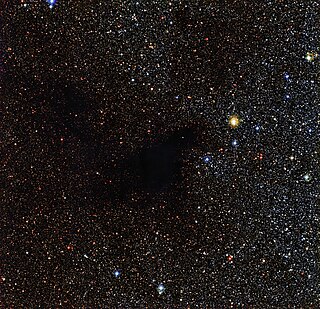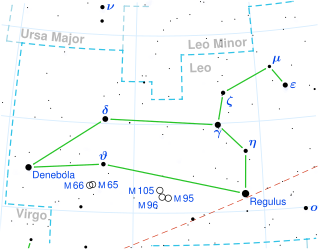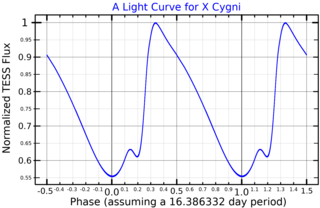107 Piscium is a single star in the constellation of Pisces. 107 Piscium is the star's Flamsteed designation. John Flamsteed numbered the stars of Pisces from 1 to 113, publishing his Catalogus Britannicus in 1725. He accidentally numbered 107 Piscium twice, as he also allocated it the designation of 2 Arietis. This star is faintly visible to the naked eye with an apparent visual magnitude that has been measured varying between 5.14 and 5.26. However, that finding of variation was not confirmed by subsequent observations and is most likely spurious data. It is located at a distance of about 24.8 light years away from the Sun. 107 Piscium is drifting closer to the Sun with a radial velocity of −33.6, and is predicted to come as close as 15.4 light-years in around 135,800 years.

In astronomy, extinction is the absorption and scattering of electromagnetic radiation by dust and gas between an emitting astronomical object and the observer. Interstellar extinction was first documented as such in 1930 by Robert Julius Trumpler. However, its effects had been noted in 1847 by Friedrich Georg Wilhelm von Struve, and its effect on the colors of stars had been observed by a number of individuals who did not connect it with the general presence of galactic dust. For stars lying near the plane of the Milky Way which are within a few thousand parsecs of the Earth, extinction in the visual band of frequencies is roughly 1.8 magnitudes per kiloparsec.

27 Aquilae is a star in the equatorial constellation of Aquila. 27 Aquilae is its Flamsteed designation though it also bears the Bayer designation d Aquilae. It has an apparent visual magnitude of 5.49, which is faintly visible to the naked eye. Based upon parallax measurements made during the Hipparcos mission, this star is at a distance of 440 light-years from Earth, give or take a 20 light-year margin of error. At this distance, the brightness of the star is diminished from extinction caused by interstellar gas and dust.

Alpha Camelopardalis, Latinized from α Camelopardalis, is a star in the northern constellation of Camelopardalis. With an apparent visual magnitude of 4.3, it is the third-brightest star in this not-very-prominent circumpolar constellation; the first and second-brightest stars being Beta Camelopardalis and CS Camelopardalis, respectively. It is the farthest constellational star, with a distance of approximately 6,000 light-years from Earth based on parallax measurements.

Rho Leonis is a binary star in the zodiac constellation of Leo, and, like the prominent nearby star Regulus, is near the ecliptic. With an apparent visual magnitude of 3.9, this star can be readily seen with the naked eye. Parallax measurements give a distance estimate of about 5,400 light-years from the Earth. Rho Leonis is an Alpha Cygni-type variable star, showing 0.032 magnitude brightness variations with a period of 3.427 days, in Hipparcos data.

Kappa Cassiopeiae is a star in the constellation Cassiopeia.

19 Cephei is a supergiant star in the northern circumpolar constellation of Cepheus. It has a spectral class of O9 and is a member of Cep OB2, an OB association of massive stars located about 615 parsecs (2,010 ly) from the Sun.

HD 34626, also known as MZ Aurigae, is an unusual variable star in the northern constellation of Auriga. It has an apparent magnitude of 8.2 and is about 3,300 light years away.
15 Sagittarii is a blue-hued binary star system in the southern zodiac constellation of Sagittarius. The estimated distance based upon photometry is around 4,200 ly (1,300 pc). It is faintly visible to the naked eye with an apparent visual magnitude of 5.37. The system is moving closer to the Sun with a heliocentric radial velocity of around −6 km/s.

111 Tauri is a wide binary star system in the constellation Taurus. It is located at a distance of 48 light years from the Sun. Primary component A is a main sequence star with a stellar classification of F8V. The secondary component B is a K-type main sequence star. The primary is larger and more luminous than the Sun, with about 130% of the Sun's radius and 185% of the Sun's luminosity. The apparent magnitude of 5.0 indicates it is a faint star that can be viewed by the naked eye under good, dark-sky conditions.

Theta2 Orionis is a multiple star system in the constellation Orion. It is a few arc minutes from its more famous neighbour the Trapezium Cluster, also known as θ1 Orionis.

TU Muscae, also known as HD100213, is an eclipsing binary star in the constellation Musca. Its apparent magnitude ranges from 8.17 to 8.75 over around 1.4 days.
WR 135 is a variable Wolf-Rayet star located around 6,000 light years away from Earth in the constellation of Cygnus, surrounded by a faint bubble nebula blown by the intense radiation and fast wind from the star. It is just over four times the radius of the sun, but due to a temperature of 63,000 K it is 250,000 times as luminous as the sun.

WR 1 is a Wolf-Rayet star located around 10,300 light years away from Earth in the constellation of Cassiopeia. It is only slightly more than twice the size of the sun, but due to a temperature over 100,000 K it is over 758,000 times as luminous as the sun.
LoTr 5 is a large, faint planetary nebula in the constellation of Coma Berenices. In 2018, its parallax was measured by Gaia, giving a distance of about 1,650 light-years.

HD 73882 is a visual binary system with the components separated by 0.6″ and a combined spectral class of O8. One of stars is an eclipsing binary system. The period of variability is listed as both 2.9199 days and 20.6 days, possibly due to the secondary being a spectroscopic binary star.

SZ Tauri is a variable star in the equatorial constellation of Taurus. The brightness of this star varies from an apparent visual magnitude of 6.39 down to 6.69 with a period of 3.149 days, which is near the lower limit of visibility to the naked eye. The distance to this star is approximately 2,070 light years based on parallax measurements. There is some indication this may be a binary system, but the evidence is inconclusive.

SY Equulei, also known as HD 203664, is a single variable star located in the equatorial constellation Equuleus. It has an average apparent magnitude of about 8.5, varying by a few hundredths of a magnitude, making it readily visible in binoculars and small telescopes, but not to the naked eye. The star is relatively far away at a distance of 8,000 light years and is receding with a heliocentric radial velocity of 48 km/s. At that distance, SY Equulei is dimmed by 0.19 magnitudes due to interstellar dust.

X Cygni is a variable star in the northern constellation of Cygnus, abbreviated X Cyg. This is a Delta Cephei variable that ranges in brightness from an apparent visual magnitude of 5.85 down to 6.91 with a period of 16.386332 days. At it brightest, this star is dimly visible to the naked eye. The distance to this star is approximately 628 light years based on parallax measurements. It is drifting further away with a radial velocity of 8.1 km/s. This star is a likely member of the open cluster Ruprecht 173.
HD 116852, also known as HIP 65890, is a solitary, whitish-blue-hued star located in the southern circumpolar constellation Chamaeleon. It has an apparent magnitude of 8.47, making it readily visible in binoculars but not to the naked eye. The star is located relatively far at a distance of 6,310 parsecs but is drifting closer with a heliocentric radial velocity of −47 km/s. At its current distance, HD 116852's brightness is diminished by 0.67 magnitudes due to extinction from interstellar dust. It has an absolute bolometric magnitude of −9.0.















